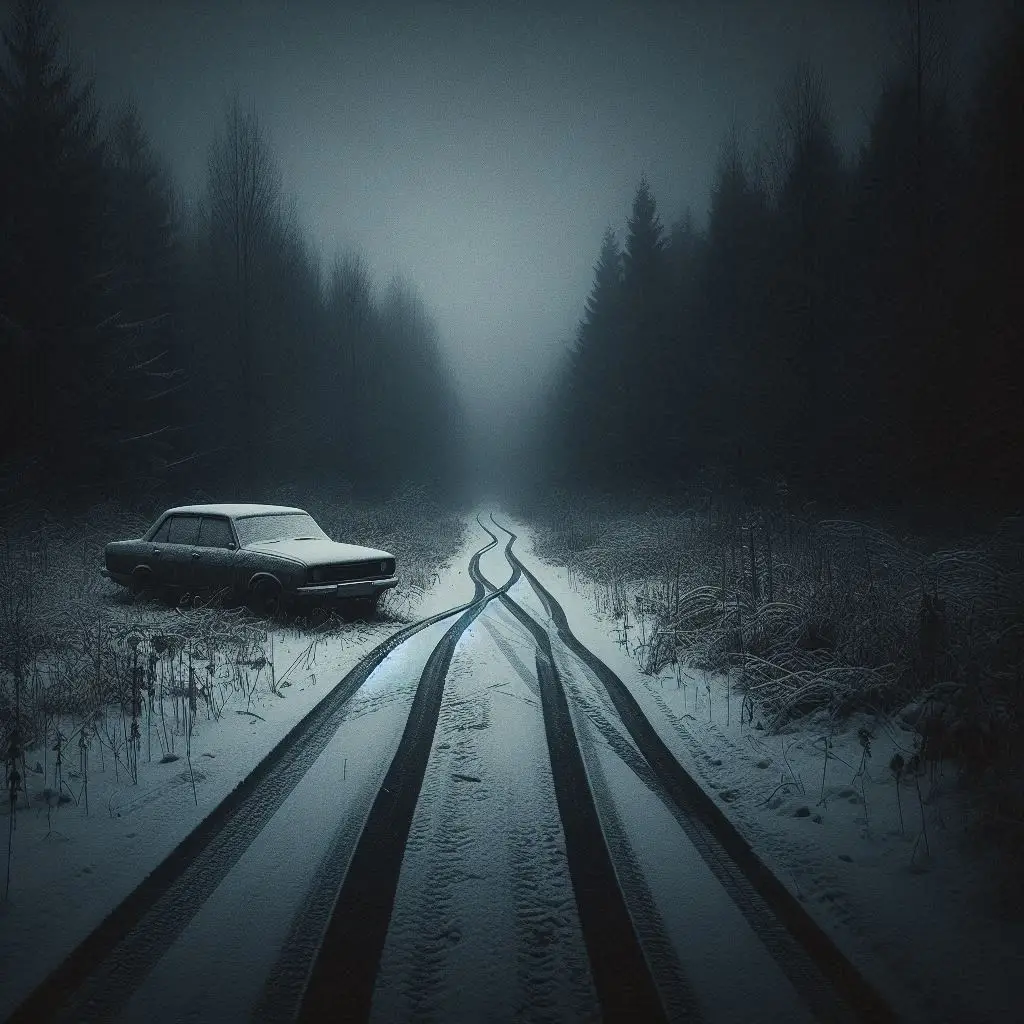It was a freezing February night in 2004 when a young woman’s car was found crashed on a rural New Hampshire road. The airbags had gone off, the windshield was cracked, and in the snow, the faint outline of her footprints trailed away from the scene — and then vanished.
Her name was Maura Murray, and in the twenty years since that night, her disappearance has become one of the most haunting and debated mysteries in America. A mystery filled with strange phone calls, packed bags, a fake death, and a scream that no one can ever seem to explain.
A Promising Life — and a Sudden Collapse
Maura Murray was 21 years old, a nursing student at the University of Massachusetts Amherst. She was smart, athletic, and responsible — the kind of girl her professors said would go far. But underneath that promising future, something was unraveling.
In early February 2004, Maura’s life seemed to suddenly shift. She’d been caught using a stolen credit card a few months earlier — a minor offense, but one that weighed on her. She was also juggling a difficult long-distance relationship with her boyfriend, Billy, an Army lieutenant. They’d been fighting lately, mostly about trust.
On February 5th, Maura was working her shift at the campus security desk when she got a phone call from her sister. Whatever was said on that call shattered her composure. A co-worker later said she broke down crying, completely unresponsive, repeating only, “My sister.”
No one knows what that call was about. But it seems to have marked the start of something bigger — something that would spiral into a mystery that still has no end.
The Email, the Lies, and the Disappearing Act
Four days later, on February 9th, Maura emailed her professors and told them she’d be missing class for a week because of a death in the family. It was a lie. No one in her family had died.
Then she packed her car — carefully. She brought clothes, toiletries, textbooks, and her favorite stuffed animal. She withdrew nearly $300 from her bank account and bought alcohol: wine, Kahlua, Baileys, vodka. It looked less like a random trip and more like someone planning to disappear.
Before leaving, Maura searched directions to Bretton Woods, New Hampshire, a remote mountain area near the White Mountains. It was winter — icy, quiet, and sparsely populated. No one knows why she picked that spot.
Around 4:30 p.m., she emailed her boyfriend: “I love you more than anyone. You are my everything.” Then she got in her black Saturn sedan and started driving north.
She was never seen alive again.
The Crash on Route 112
At 7:27 p.m., a resident of the small town of Haverhill, New Hampshire, called 911. She reported a car accident outside her home on Route 112, also known as the Wild Ammonoosuc Road.
When she went to check, she saw a young woman standing beside the car — slim, brown hair, no coat. The woman said she was fine, that she’d called AAA. The resident offered to help, but Maura declined. There was no cell signal in that area, and AAA confirmed she never called.
A passing bus driver also stopped. He asked if she needed him to call the police, but she insisted she was okay. The driver drove away but called 911 anyway.
By 7:46 p.m., police arrived at the scene. The car was there. Maura was gone.
Her purse, cell phone, and nearly all her belongings were missing. But the car keys and a box of wine were still inside. There was a strong smell of alcohol in the air, suggesting she’d been drinking. The car had spun out on a curve and hit a tree, but not hard enough to cause major injury.
Her footprints led east into the snow for about 100 yards — and then stopped.
It was as if she had been swallowed by the night.
The First Search
Police launched a massive search effort. Dogs, helicopters, snowmobiles — they covered every inch of Route 112 and the surrounding woods. The dogs tracked her scent for only a short distance before losing it near the road.
No signs of a struggle. No blood. No dropped belongings.
It was as if Maura had vanished between heartbeats.
At first, investigators assumed she might have wandered off into the woods, disoriented or drunk, and succumbed to the cold. But there were no tracks suggesting she went deep into the trees.
Then people began to notice the timing. Maura’s disappearance had an eerie similarity to another local case — a young woman named Brianna Maitland, who vanished a month later after her own car was found abandoned in a rural area in Vermont, less than 100 miles away.
Two young women. Two crashed cars. Two vanishings. No trace.
Theories exploded overnight.
A Web of Secrets
As investigators dug deeper into Maura’s life, strange details began to surface.
Her father, Fred Murray, told police that he and Maura had gone car shopping just two days before she disappeared. That night, Maura crashed his car on her way home from a party. Police let her go with no charges, but Fred later said she was distraught. She’d called him crying that night, terrified of disappointing him.
Then came the mystery phone calls.
The night before she vanished, Maura made multiple calls — to motels, to rental agencies, to a fellow nursing student — but left no explanation. One call stood out: she phoned a number that connected to a man who once owned a condo near Bretton Woods, the area she was driving toward. The condo wasn’t in use, but investigators never determined why she called.
And perhaps strangest of all — the packed car. Her dorm room had been cleaned out. Boxes were neatly stacked, and photos were removed from the walls.
Was Maura running away from something? Or to someone?
The Roadside Scream
Over the years, one of the most chilling claims came from a nearby resident. She told police that on the night of Maura’s disappearance, around 8 p.m., she heard a terrifying sound — what she described as a “blood-curdling scream” — echoing through the woods.
Police never confirmed the report. But for locals, that detail became an obsession.
If true, it meant Maura might have been attacked — perhaps by someone who picked her up. The road where she crashed was isolated, bordered by thick woods and old farmhouses. A driver passing by could have easily stopped without being noticed.
But no one ever came forward.
The Theories
Nearly twenty years later, the Maura Murray case has split into two camps: those who believe she met with foul play, and those who think she walked away intentionally and started a new life.
If it was foul play, who did it? Locals have pointed fingers at everyone from nearby residents to passing truckers. True crime forums buzzed for years about a man who lived a few miles away and owned a red pickup truck seen near the scene that night. He was questioned, but never charged.
Others believe Maura staged her disappearance. They point to the lies — the fake death email, the packed car, the cleaned dorm room. Maybe she’d been overwhelmed by life, by guilt, by the pressure to be perfect. Maybe she just wanted to start over.
There’s even a theory that she planned to meet someone — possibly an online connection or secret boyfriend — and something went wrong.
But here’s the chilling part: despite endless speculation, no one can prove anything. There’s been no confirmed sighting of Maura Murray since February 9, 2004. Not a single trace of her body, belongings, or digital footprint has ever surfaced.
A Family’s Endless Search
Fred Murray has never stopped searching for his daughter. He’s spent years combing the New Hampshire wilderness, appearing on news shows, and demanding answers from police.
“I’m not giving up until I find her,” he told reporters in one emotional interview. “Somebody knows what happened to Maura. Somebody saw her that night.”
Maura’s siblings have carried the torch too, keeping her memory alive through social media and advocacy work. They’ve pushed for modern searches using ground-penetrating radar and cadaver dogs, but so far, nothing.
It’s like she’s out there — somewhere — just beyond reach.
New Clues, Old Questions
Over the years, new evidence has surfaced — and each time, hope flickers before fading again.
In 2019, a house near the crash site became the center of attention. A cadaver dog allegedly alerted to the smell of human decomposition in the basement. Police searched it, but results were inconclusive.
In 2021, ground-penetrating radar scans near the property found possible anomalies under the concrete floor. When authorities finally dug it up, they found nothing.
Online, theories multiply by the day. Some claim she was taken by a local who offered help. Others believe she hit her head in the crash, became disoriented, and succumbed to the cold.
And then there are the darker theories — that someone in her life helped her vanish on purpose.
But with no body, no DNA, and no solid leads, the truth stays hidden beneath years of speculation.
The Woman in the Woods
In 2014, ten years after Maura vanished, a hiker in the White Mountains claimed to have found a blue fleece jacket deep in the woods — the same color and size Maura wore. For a moment, it felt like a breakthrough.
Police tested it. It wasn’t hers.
But that discovery brought renewed attention to the case. Podcasts, documentaries, and even Reddit threads reignited the story. New people began looking, new ideas surfaced. And yet, just like the footprints in the snow, every lead ended in the same place — nowhere.
The Legacy of Maura Murray
Maura’s disappearance changed how missing persons cases are handled in New England. It also gave birth to one of the internet’s first “crowd-sourced investigations,” with thousands of people across the world examining maps, police logs, and photos, trying to solve the mystery.
But it also divided people. Some accused the family of hiding secrets. Others pointed fingers at the police for mishandling evidence.
In the middle of it all, Maura became less of a person and more of a symbol — the girl who vanished on the side of the road and never came home.
Her story reminds us of how fragile safety can be. One small decision — one wrong turn — can lead to a lifetime of unanswered questions.
The Night on Route 112
The last confirmed image of Maura Murray is burned into memory: a small figure standing beside a dark car, its headlights glowing in the snow. Her breath visible in the freezing air. A bus driver offering help, a polite refusal, and then — silence.
Minutes later, she was gone.
Some say she ran. Some say she was taken. Some think she’s buried somewhere under those woods, her story frozen in time.
But until someone finds her, Maura Murray remains both everywhere and nowhere — a ghost caught between two worlds, forever walking down that lonely New Hampshire road.
Closing Thoughts
It’s been twenty years. The trees on Route 112 have grown taller, the road repaved, the snow still falls every winter. But on cold nights, when the wind howls through the mountains, locals say you can almost hear something else — faint, distant, like the echo of a woman’s voice calling out for help that never came.
Packed bags, a fake death, and a roadside scream. The clues are all there, tangled together in a mystery that refuses to die.
Until she’s found, the question remains: what really happened to Maura Murray?




